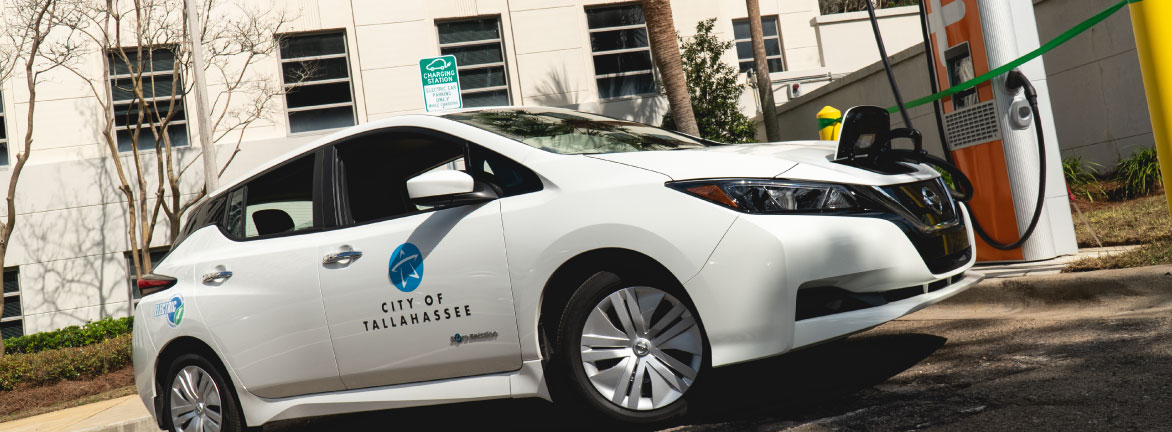City of Tallahassee
Resources and Solutions
for our Community
Solutions for You
The City of Tallahassee Utilities offers a variety of products, services, incentives, and tools to help you better manage your utilities and save money. As interest in solar energy, electric vehicles, and going green at your home and business grows, here are a few tools to help guide your way.

Rooftop Solar
Our online tools help you make an informed decision about buying solar panels

Electric Vehicles
Our online tools help you make an informed decision about buying an electric vehicle.

Going Green
Energy efficiency upgrades to your home and business can you save money in the long run.

Incentives
We offer a variety of rebates, grants, and loan financing to help you save money.
 Rooftop Solar Rooftop Solar
Use our solar adviser tool to find out if a solar panel installation is right for your home.
New to solar? Explore solar energy basics at: NREL.gov (External Site)
Are there incentives to go solar?
Solar Net-Metering: Install approved PV or solar electric panels that operate in conjunction with the City's electric grid. This will provide your home and the City with clean and renewable energy. When you're generating more power than you can use with rooftop solar photovoltaic panels, your electric meter will essentially "spin backwards" with net-metering, thereby lowering your monthly electric bill. Excess solar energy produced during the daytime typically offsets consumption at your premise at night. Excess power (generated by small to moderate-sized PV units-up to 100 kilowatts) may be returned to the City of Tallahassee Utilities at the full retail value, including taxes. To learn more, visit the Solar Net-Metering page on Talgov.com.
The City offers on-bill financing for Solar Photovoltaic (PV) Systems qualifying homes. Visit the Energy-Efficiency Loans for Residential Customers page on Talgov.com for more information. Additionally, the 2022 federal Inflation Reduction Act revives a 30% tax credit for installing residential solar panels and extends the program until Dec. 31, 2034. Home battery storage also qualifies.
Should I consider a Battery Backup System?
When the utility grid goes down and you lose electric service, you can use a battery system to power some or all of your household electricity needs (called “loads”). Loads can range from small (light bulbs, toasters, a hair dryer) to large (a refrigerator or a well pump). Solar is the perfect partner for battery storage. A properly sized and configured solar system will re-charge your batteries on a daily basis, providing the “fuel” to keep your battery fully charged and ready for use. It’s important to note that, without batteries, your solar system will not provide electricity to your home during a power outage. This is because solar systems are required to automatically shut off if the grid goes down. This is done to ensure that they do not “backfeed” power onto the lines and injure workers that are repairing the electric line. To learn more, read the Solar United Neighbors Battery Guide (External Site).
Interested in a career in solar?
The Solar Career Map explores an expanding universe of solar-energy occupations, describing diverse jobs across the industry, charting possible progression between them, and identifying the sorts of credentials necessary to do them well. Visit the Solar Career Map at IRECSolarCareerMap.org (External Site).
 Electric Vehicles Electric Vehicles

Our online tools help you make an informed decision about buying an electric vehicle.
Electric vehicles are fast, fun, affordable and efficient. Compared to gas-powered vehicles, EVs are cheaper and simpler to maintain and will cost you less to operate. EVs also significantly reduce carbon emissions.
Which EV should you choose? Start with this simple EV Advisor Tool (External Site) and other helpful EV resources from Drive Electric Florida (External Site).
There are two ways to Charge your EV at Home:
- Level 1 (120-volt) charging uses any standard outlet and the charging cable that came with your EV. Charging at Level 1 adds about 3 miles of range per hour and is best for those with short commutes or with frequent access to chargers.
- Level 2 (240-volt) charging requires 240 volts and adds range much more quickly. Depending on the charging solution and the charging rate of your vehicle, Level 2 charging adds between 12 and 50 miles of range per hour.
If you already have a 240-volt outlet (dryer outlet) in your garage, you may be able to charge your EV with the use of a charger. Some vehicles can plug directly into the outlet.
Hybrid Vehicle
Uses a gas engine and electric motor
Cannot be plugged in.
Small battery.
Battery travel range"
Examples:
• Toyota Prius
• Hyundai Ioniq Hybrid
Plug-In Hybrid Vehicle (PHEV)
Uses an electric motor and gas as a backup fuel.
Can be plugged in to fuel.
Medium battery.
Battery travel range:
Typically 20-40 miles
Examples:
• Toyota Prius Prime
• Jeep Wrangler 4XE
• Honda Clarity
Battery Electric Vehicle
Uses an electric motor only.
Must be plugged in to fuel.
Large battery
Battery travel range:
Typically 150-350 miles
Examples
• Tesla
• Hyundai Ioniq Electric
• Nissan LEAF
Don’t own your home? If you’re a renter interested in making the switch to EV, there are a growing number of options for you. View the map of public charging stations (External Site).
Other helpful resources include:
Apartments and Condos
Workplace Charging
You can find additional insights in Charged Future's guide to owning an electric as a renter (External Site).
Under the Inflation Reduction Act, a tax credit worth up to $7,500 for buyers of new all-electric cars and hybrid plug-ins would be extended through 2032. The bill would also create a separate tax credit worth a maximum $4,000 for used versions of these vehicles. See “e+ Incentives” section below for more details.
 Going Green Going Green
Energy Efficiency Upgrades
An energy audit is one of the best ways to identify energy problems as well as opportunities to save energy, water and money. It can help you prioritize and focus your efforts. For some of the City's products & services, such as ceiling insulation grants, solar loans, and solar rebates, an energy audit is a necessary first step. To get started here, the Florida Office of Energy created this interactive tool. Alternatively, consider scheduling a free Home Energy Audit from the City of Tallahassee.
 Incentives Incentives
City Rebates, Grants, and Loans
The City offers a variety of rebates, grants, and on-bill financing for energy efficiency upgrades to your home and business. To learn more and get started, visit: Talgov.com/YOU.
Incentives from the Federal Government
The Inflation Reduction Act (IRA) of 2022 was signed into law on August 16, 2022. The IRA makes major investments in climate change, domestic energy production and manufacturing, and healthcare, while aiming to reduce the budget deficit. The bill is said to put the U.S. on a path toward a forty percent reduction in carbon emissions by 2030. The following incentives are some highlights from the IRA, and more information can be found in the below links. Disclaimer: Please consult your tax adviser to make an informed decision.
Federal Incentives for Residents
Includes incentives to buy energy efficient and electric appliances, clean vehicles, rooftop solar, and home energy efficiency upgrades.
- Rebates for income-qualified households
- Total family annual income must be less than 150% of the median income where you live to qualify.
- Qualifying homeowners can get rebates for as high as:
- $840 for stove, cooktop, range, oven, or heat pump clothes dryer
- $1,750 for a heat pump water heater
- $8,000 for a heat pump for space heating or cooling
- $1,500 for insulation, air sealing, and ventilation
- $2,500 for electric wiring
- $4,000 for an electric load service center upgrade
- Consumer tax credits
- 30% of the costs for all eligible home improvements
- Lifetime limit of $500 in efficiency credits has been expanded to $1200 annual limit on the credit amount. Annual limits for specific types of qualifying improvements:
- $150 for home energy audits
- $250 for an exterior door ($500 total for all exterior doors)
- $600 for exterior windows and skylights; central air conditioners; electric panels; natural gas, propane, or oil water heaters
- $2,000 for electric or natural gas heat pump water heaters or heat pumps
For more information, please visit: Kiplinger.com/taxes/605069/inflation-reduction-act-tax-credits-energy-efficient-home-improvements
- Existing credit is maintained: up to $7,500 consumer credit for the purchase of a qualified new clean vehicle (electric vehicles, plug-in hybrids, hydrogen fuel cell vehicles)
- New consumer tax credit for purchase of used non-commercial clean vehicle
- Credit equal to lesser of $4,000 or 30% of vehicle cost
- Sets maximum sale price of $25,000
- Model must be at least two years older than the year of sale
- Income eligibility of $75,000 or $150,000 for joint filers
Federal Incentives for Businesses
- $1 billion grant program for energy efficient upgrades in affordable housing
- Tax credits for energy efficient commercial buildings
- Up to $5 per square ft to support energy efficiency improvements
- Up to 30% of costs of installing solar power and purchase of clean commercial fleet
For more information, please visit: Utility Dive-IRA_CleanEnergyManufacturing
- Commercial clean vehicle credit
- $7,500 tax credit for class 1-3 (under 14,000 lbs.)
- $40,000 for class 4 and above (over 14,000 lbs.)
For more information on the Inflation Reduction Act regarding climate and energy impacts, please visit:
- Electrification Coalition (External Site)
- Database of State Incentives for Renewables & Efficiency (External Site)
- The White House (External Site)
- U.S. Department of Energy (External Site)
- WFSU (External Site)
|